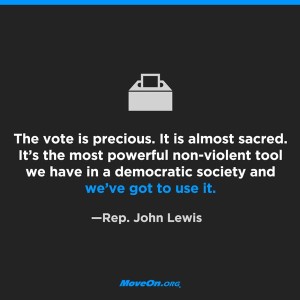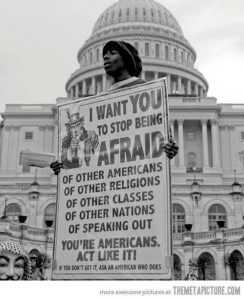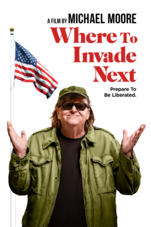The movement begins.
May 18, 2016Brand New Congress
‘Let’s elect a Brand New Congress that works for all.’
‘Right now, this is just an idea that some of us Bernie volunteers and former staff have been talking about with each other. We’re all busy working for Bernie until he’s in the White House. But we’re proposing the campaign for a Brand New Congress as something to work on next. Only something as big and worthwhile as this can keep the revolution going—and it’s the only way to give Bernie the ability to make real change from the White House. If you would like updates or to get involved, please sign up and one of us will be in touch.’
[…]
Recruit candidates and organizers
‘We are asking supporters to organize events for a Barnstorm tour to hit a whole bunch of cities in the country. We’ll spread the idea, recruit organizers and scout candidates. Local organizers will continue the Barnstorms themselves to every Congressional District in their area.’
Birth of a Nation.
May 17, 2016The Sundance standout from actor-writer-director Nate Parker hits theaters Oct. 7.
‘The Birth of a Nation has debuted its first poster…with a little twist.
The movie has gotten a “living” poster — a digital video that sees the graphic design of slave revolt leader Nat Turner being bled onto the screen, eventually yielding the movie’s poster.
Nate Parker wrote, directed, starred in and produced the film, which follows the story of Turner and his failed slave rebellion in the antebellum south.
The Sundance standout, which sold for $17.5 million to Fox Searchlight, further prompted the diversity debate during the whitewashed awards season.’
(Hollywood Reporter)
‘Community is just doing my part.’
May 16, 2016pp. 128-129
‘You tell a lot of stories of people you met on the road. And they’re the kind of stories that we’re becoming familiar with. Stories of good people who are working too many jobs and still not getting by. Stories of college students who are carrying way too much to be able to focus on college. Stories of people who don’t have the money to get the care they need and die too young. I am aware in my self and I think all around me, maybe, those of you in this room – – there are so many of us anguished about these gulfs that seem to be growing in our society, in our community, and in our nation. And it’s not that we don’t care. We care deeply. But we don’t know how to connect that care in meaningful, practical ways. To do something about it.’
[…]
‘There are several levels of that. One is the doing something. I sometimes think we, in the United States, think we ought to do something about everything and that it’s my job to fix everything. Well it’s not That’s way beyond us. It’s more important, I think, that we listen deeply to our stories and then see where it leads. And that’s the piece. If we all do our part…’
The alphabet of the heart.
Alphabet of the Heart, by Dr. James Doty, professor in the Department of Neurosurgery at Stanford University and the director of CCARE, Center for Compassion and Altruism Research and Education.
CDEFGHIJKL
C=Compassion. Recognizing the suffering of another with a desire to alleviate that suffering…beginning with ourselves.
D=Dignity. It needs to be acknowledged and recognized in every person.
E=Equanimity. Evenness of temperament even during difficult times.
F=Forgiveness. The greatest gift to give to another and ourselves.
G=Gratitude. The recognition of the b lessing that our life is – – even in pain and suffering.
H=Humility. Only when we look at another as equals can we truly connect.
I=Integrity. Intention. Defining values most important to us.
J=Justice. Recognition that within each of us there lives a desire to see that right be done. Seek justice for the vulnerable, care of the weak, give to the poor.
K=Kindness. A concern for others as an active component of compassion.
L=Love. It is love that contains all virtues. It is love that holds our humanity.
Michael Moore…
‘I truly and unapologetically believe that if everyone saw it, it would be President Sanders in a cakewalk.’
(Now available on DVD)
It couldn’t come at a better time.
May 12, 2016
In long interview narrative, Noam Chomsky explains it all for us, in the simplest of terms as only a professor can. Using interviews filmed over four years, Noam Chomsky discusses the deliberate concentration of wealth and power found in the hands of a select few. It is 1:12 in length – – every minute is riveting and revealing.
Here’s a review from rogerebert.com:
“Requiem for the American Dream,” a film by Peter Hutchison, Kelly Nyks and Jared P. Scott, might be subtitled “Professor Chomsky Explains It All for you.” As Errol Morris did with Robert McNamara in “The Fog of War,” the directors here point their cameras in close-up at Noam Chomsky for a feature-length disquisition that’s interspersed with snazzy graphics and illustrative archival footage. In large part because Chomsky is a very good speaker with a wealth of incisive ideas to share, the result is a film that feels less like a lecture than a provocative X-ray of current American political realities.
It couldn’t be more timely, not only because the idea that it is its heart—the impact of the concentration of wealth and power on our politics—has received so much attention of late, but more specifically because its animating concerns are central to the current year’s presidential election. For that reason, its appeal could be more ecumenical than might be assumed. How many Americans currently would agree that the American dream is in big trouble? A good percentage, recent polls suggest. That’s why Chomsky’s leftist analysis, as a starting point for discussion at the very least, could offer as much food for thought for the supporters of Donald J. Trump as it will sustenance for Bernie Sanders’ legions.
The film’s title aptly pinpoints its area of interest. Though Chomsky, a veteran MIT professor who first gained renown for his groundbreaking work in linguistics, comments frequently on global conflicts and America’s involvement therein, we hear almost nothing on those subjects here (which even the film’s admirers might consider a weakness). The upside to this decision, though, is that the discussion has a tight, logical focus that aids its clarity and organization.
In essense, Chomsky asks why America seemed to reach the zenith of its economic and civic vibrancy in the 1950s and ‘60s and then go into a decline that has left few except the top tenth of a percent of Americans truly fulfilled or satisfied. To answer the question, he constructs a narrative that entwines ideas and events, both harkening back to 1776. In that year, British moral philosopher Adam Smith published “The Wealth of Nations,” in which he argued that merchants and manufacturers dominate government in defense of their own interests regardless of how it affects the rest of society. In examining the government that resulted from the American Revolution, begun in the same year, Chomsky finds that even James Madison, whom he calls as a great a believer in democracy as anyone then, wanted U.S. society controlled by “the wealthy”—property owners might be a better term—which he thought was the most “responsible” element of the citizenry. Thus was launched a never-ending battle between those desiring more democracy from below against those seeking more elite control from above.
The ideas Chomsky presents are necessarily simplified for the sake of compression, and trying to summarize them briefly simplifies them even more. But their gist is clear and worth pondering. In post-World War II America, he suggests, there was a direct correlation between the average worker having a job that allowed him to own a home, support a family and educate his kids, on the one hand, and, on the other, the facts that the wealthy were taxed at a high rate, businesses were engaged mainly in making products designed to sell (which their workers could afford to buy), and the power of lobbyists and corporations in Washington was relatively limited.
The 1960s changed much of that. While the civil rights, antiwar and feminist movements transformed society with an upsurge of democratic activism from ordinary citizens, the powerful, alarmed at their loss of control, reacted with fierce efforts to consolidate and extend it. (Chomsky doesn’t note how many non-elite Americans were also alarmed by the turmoil in the streets, though he does ponder the irony that Richard Nixon, who benefited from their reaction, was a raving progressive compared to those who came later.) The eventual consequence was a country that was like the ‘50s turned upside down: through deliberate efforts to undermine job security, the middle class was hollowed out both economically and psychologically; while less wealthy, post-WWII America was able to give free or low-cost college educations to most students, today’s graduates are shackled with huge debts that help make them passive workers; corporations now devote far less energy to making products than to making money through moving it around, and protect their powers by, in effect, buying the kind of government that helps them maintain and increase that power.
Chomsky aptly calls the process he describes a “vicious cycle”—the more money that goes into politics with the intent of influencing it, the more our politics is ruled by money rather than any other definition of national welfare. The baneful effects of the Citizens United decision, which effectively removed all limits on how much money corporations can pour into elections, are noted, but Chomsky also blasts the influence of advertising culture as well as the modern media, which have helped turn citizens seeking useful information to make rational decisions into passive consumers, addicted to shopping, hypnotized by their devices and increasingly prone to making irrational, emotional decisions that are actually contrary to their own interests.
The politics of image may be ubiquitous and inescapable now, but they are not for Chomsky. “I don’t agree with Sarah Palin about much,” he says, before he shares her scorn for the “hopey, changey thing” that many swayed voters two presidential elections back. It’s a caveat that both sides might consider in 2016, even if the direness of Chomsky’s analysis suggests that the real requiem he’s offering is not for the American dream but for American self-government, a good idea while it lasted.
Chomsky’s thoughts on a Trump presidency:
Know it. Show it. Be it.
May 10, 2016The human side of economics.
May 7, 2016Thriving with value. The profit goal is neglecting the human side of economics.
Compassion and care.
Seth Godin:
‘I’m not sure that anyone has a calling. I think, instead, our culture creates situations where passionate people find a place where they can make an impact. When what you do is something that you make important, it doesn’t matter so much what you do.
It’s not that important where. It matters a lot how. With passion and care.‘
✿`*•✿ ✿`*•✿
Freedom.
May 1, 2016Whisper.
Seth Godin:
‘The solution is simple: whisper.
Practice whispering.
Whisper when you type, whisper when you address a meeting.
Lower your voice, slow your pace, and talk more quietly.
The microphone will amplify your words. And we’ll hear them.’









